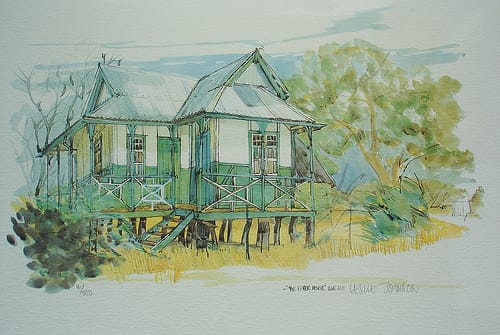Prefab

The Paper House by Leslie Johnson courtesy of Morris Sloman
Prefab
The first prefabricated building in Southern Rhodesia, erected at the Globe and Phoenix Mine as its first manager’s house, was constructed out of panels of paper maché on wire netting, hence the name, The Paper House.
Prefab
The house was manufactured in Britain, shipped to Que Que just before the turn of the century and brought north by ox wagon from Port Elizabeth, somehow negotiating through the Matabele Rebellion and the rindepest epidemic. Cecil John Rhodes slept here. The Paper House has style, besides being practical. It’s built on stilts to protect against the white ants and damp, which makes it sit daintily on the landscape and yet it still stands today. The wrap-around verandah, though modest, is a prerequisite for any self-respecting colonial house. The tin roof shimmering in the heat has a generous pitch to deflect the deluge of rain from afternoon summer thunderstorms. It’s all set about with Rhodesia’s indigenous family of acacia trees with grasses yellowed by the white hot glare of the African sky. At the time, every other building was either a tin shack, hot by day and cold by night, or made like an African hut out of pole and dagga (mud) with a thatch roof.
After the advent of rail in 1902, the secluded, grand rambling Phoenix House, with its extensive gardens, was built for the manager. The Paper House then became the mine manager’s office. The painting reflects how Dad saw the The Paper House a half century later, on his way to work, summoned by the wail of the mine hooter, signaling the start of the morning shift. Sick Parade at the Native hospital, at seven o’clock, started his day, every day.
European and Native hospitals had been built in 1896. The natives were amazed that a building was set aside exclusively for the treatment of the sick, along with attendant doctor and orderlies and were wary. Opposing tribes refused to share a ward. But by the time Dad arrived the hospital sported a portable X-Ray, primitive operating theatre and elementary laboratory. It was all rudimentary and crude but the basics were there for a wider practice and a challenge to upgrade, which he relished.
Soon after Dad’s arrival, the Chairman of the Board of Directors and his wife visited from the London Head Office. Dad was to show her around the medical facilities while her husband went underground. Dad was waylaid. He made his apologies: delivery of twins by Caesarian section took precedence, assisted by the Assistant Compound Manager, A. J. Liebenberg, enthusiastic but untrained, as anaesthetist under his direction.
At the officials dinner that evening the Chairman’s wife admonished her husband “You can’t expect the doctor to struggle so under those conditions and he is doing such good work. You should see the beautiful Native twins he delivered today.” She was as good as her word. A new modern theatre table and Boyle’s anaesthetic apparatus arrived in due course, a great boost to Dad’s planned upgrades.
In this new century, with other wars and new disease, many of the old icons of those early years, the Phoenix House, and the mine doctor’s house are still there but most remarkably that landmark, the prefab Paper House still stands, now a national monument, a reminder of the tenacity of the pioneers to get the mine underway.
The spirit remains: there’s yet more life in the mine, new adventurers digging in and new fortunes to be made for risk- tolerant investors. Recently Lee John, an Australian, has resuscitated the defunct Globe and Phoenix Mine and has plans for the whole Sebakwe area.
http://olympicgoldmines.com/projects.htm
This charming water color by Leslie Johnson is shared on the blog courtesy of Morris Sloman. Thanks indeed Morris.
